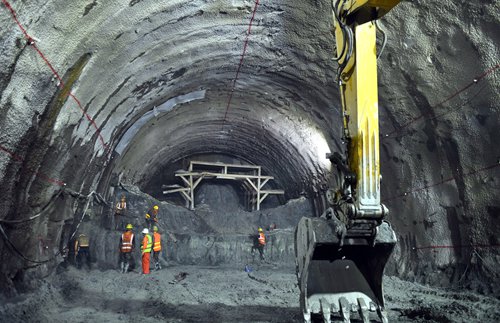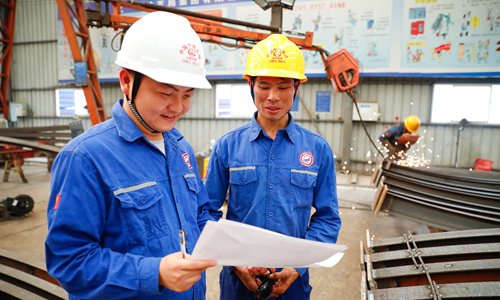HOME >> BUSINESS
Hot on the tracks of China-Laos railway construction
Source:Xinhua-Global Times Published: 2019/8/6 17:23:40
Chinese workers overcome harsh conditions for BRI connectivity project

Workers at a tunnel of the China-Laos railway project in Yuxi, Southwest China's Yunnan Province, in April Photo: Xinhua

Employees from China Railway No. 5 Engineering at a workshop in Luang Namtha Province in northern Laos in March Photo: Xinhua
Rainy season is relatively cool in late July for the Namor District of Oudomxay Province, some 400 kilometers north of the Lao capital Vientiane, while at the Ban Konlouang Tunnel construction site inside the mountains there, Chinese workers are sweating.
The 9,020-meter Ban Konlouang Tunnel is the second-longest tunnel along the China-Laos railway in northern Laos, and is currently being constructed by China Railway No. 5 Engineering Group (CREC-5).
With harsh geological conditions including faults, underground rivers, water inrush and mud, the tunnel construction site is known as the "Geological Museum".
The construction has been listed as a key bottleneck of the railway project.
At the site, heat waves erupt from the depths of the tunnel, hitting incomers as they approach. Even standing still, people can feel sweat dropping down their necks in the sauna-like passage.
When this reporter went into the under-construction tunnel in late July, workers were kneeling on an ice pile made up of dozens of large ice blocks.
"The happiest thing in this stuffy tunnel is to take a 10-minute rest on the ice pile," said Wang Hong, a construction worker, wiping the sweat from his face. "Without the ice, I really don't know how to continue with the job."
According to Wang, the average temperature in the tunnel exceeds 45 degrees Celsius.
In order to keep cool inside the tunnel and create a better environment for the workers, CREC-5 project management has purchased an ice machine to provide some five tons of ice every six hours to help regulate temperatures.
"Look, so much water can be squeezed from my clothes," Wang, in his 40s, said with a smile, adding that working in the tunnel for 10 minutes will turn his clothes into a "raincoat," and that working in this environment means he is prone to serious rheumatism.
Wang, who has been working in tunnel construction since 1999, has been a part of the construction of more than 20 tunnels. He said the Ban Konlouang Tunnel of is the hottest he has ever worked on, and also the tunnel with the most difficulties.
Even so, Wang and his team have set a record along the China-Laos railway, for a monthly excavation length of 186 meters.
After a 10-minute rest, Wang and the workers drank their full kettles of water and then left the ice pile for the tunnel, while another group of Chinese workers arrived to find their own relief from the heat.
In the staff dormitory later that evening, the first thing Wang and his colleagues did was to turn on their electric blankets. Although the region is relatively cool during rainy season, the temperature at night in Oudomxay can reach around 25 degrees celsius.
This cannot be said to be cold, so why do the Chinese tunnel workers turn on their electric blankets?
It transpires that during the rainy season, continuous precipitation not only brings coolness but also dampness. Workers need to prepare electric blankets and spend an hour or so every day drying their sheets and quilts.
According to Wang's team worker, Qiu Liping, they spend their daylight hours in the tunnel and so must use electric blankets at night instead of drying their sheets and quilts in the sun.
He said that when waking up in the morning, he can see small drops of water on the quilt because of recent heavy rains.
"Although the conditions are difficult, joining the Belt and Road construction makes me feel proud. Not only have I enriched my knowledge, but also improved my professional skills," said Qiu.
Being the first overseas route connected to the railway system in China using Chinese technology and equipment, the China-Laos railway is a major project in infrastructure inter-connectivity between China and neighboring countries, and a major project in implementing the Belt and Road Initiative.
The railway's ground-breaking ceremony was held in December 2015, and the construction of the route officially commenced a year later. The railway is expected to open for service in December 2021.
The China-Laos railway has a length of over 414 kilometers, with 62 kilometers of bridges and 198 kilometers of tunnels under construction, linking the Mohan-Boten border gate in northern Laos with the capital, Vientiane. Operating speed on the route is designed to be 160 kilometers per hour.